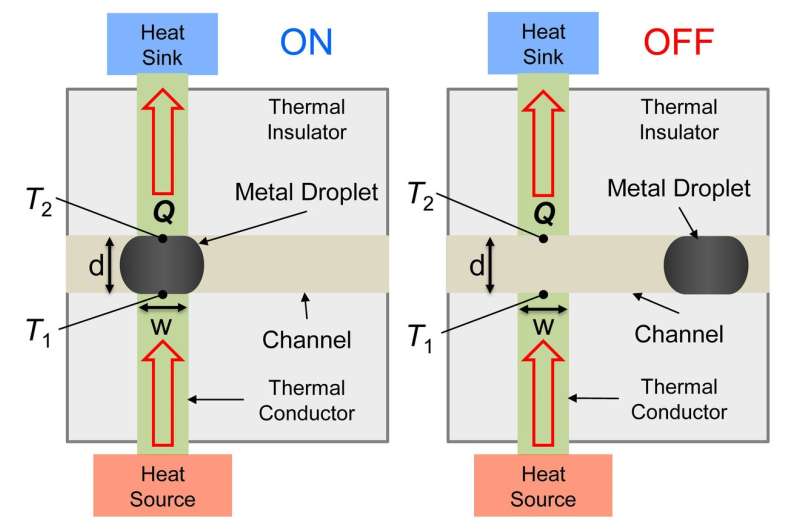Researchers develop heat switch for electronics

Researchers at the University of Illinois at Urbana-Champaign have developed a new technology for switching heat flows 'on' or 'off'. The findings were published in the article "Millimeter-scale liquid metal droplet thermal switch," which appeared in Applied Physics Letters.
Switches are used to control many technical products and engineered systems. Mechanical switches are used to lock or unlock doors, or to select gears in a car's transmission system. Electrical switches are used to turn on and off the lights in a room. At a smaller scale, electrical switches in the form of transistors are used to turn electronic devices on and off, or to route logic signals within a circuit.
Engineers have long desired a switch for heat flows, especially in electronics systems where controlling heat flows can significantly improve system performance and reliability. There are however significant challenges in creating such a heat switch.
"Heat flow occurs whenever you have a region of higher temperature near a region of lower temperature," said William King, the Andersen Chair Professor in the Department of Mechanical Science and Engineering and the project co-leader. "In order to control the heat flow, we engineered a specific heat flow path between the hot region and cold region, and then created a way to break the heat flow path when desired."
"The technology is based on the motion of a liquid metal droplet," said Nenad Miljkovic, Assistant Professor in the Department of Mechanical Science and Engineering and the project co-leader. "The metal droplet can be positioned to connect a heat flow path, or moved away from the heat flow path in order to limit the heat flow."
The researchers demonstrated the technology in a system modeled after modern electronics systems. On one side of the switch there was a heat source representing the power electronics component, and on the other side of the switch, there was liquid cooling for heat removal. When the switch was on, they were able to extract heat at more than 10 W/cm2. When the switch was off, the heat flow dropped by nearly 100X.
Besides King and Miljkovic, other authors of the paper include Paul Braun, Racheff Professor of Materials Science and Engineering and the Director of Materials Research Laboratory; and graduate students Tianyu Yang, Beomjin Kwon and Patricia B. Weisensee (now an assistant professor at Washington University in St. Louis) from mechanical science and engineering and Jin Gu Kang and Xuejiao Li from materials science and engineering.
King says that the next step for the research is to integrate the switch with power electronics on a circuit board. The researchers will have a working prototype later this year.
More information: Tianyu Yang et al, Millimeter-scale liquid metal droplet thermal switch, Applied Physics Letters (2018). DOI: 10.1063/1.5013623
Journal information: Applied Physics Letters
Provided by University of Illinois at Urbana-Champaign


















